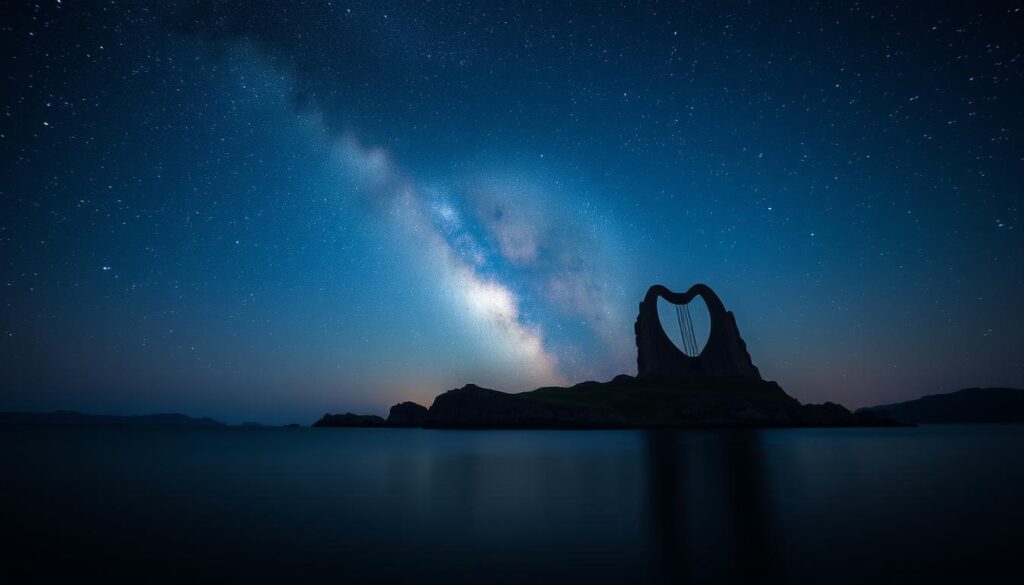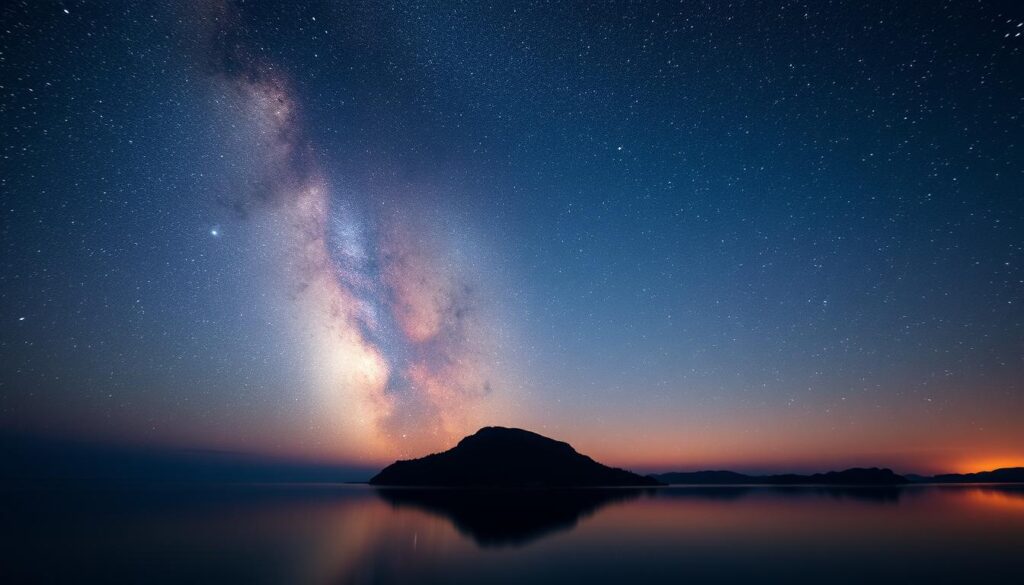
Capturing the Milky Way Above Harp Island
Can a serene island in the heart of Europe offer a perfect backdrop for astrophotography? Harp Island in Rolle, Switzerland, has become a haven for those seeking to capture the night sky in all its glory.
The commune’s proactive efforts to reduce light pollution have made it an ideal location for Milky Way photography.
Recently, the opportunity to photograph the Milky Way above this picturesque island presented a unique experience, highlighting the beauty of the night sky and the importance of preserving such dark-sky locations.
Key Takeaways
- The charm of Harp Island lies in its minimal light pollution, making it perfect for astrophotography.
- Capturing the Milky Way requires careful planning and understanding of the night sky.
- Harp Island’s efforts to reduce light pollution set an example for other locations.
- Astrophotography can be a powerful tool for promoting dark-sky preservation.
- The experience of photographing the Milky Way above Harp Island is truly unforgettable.
The Magic of Nighttime Photography at Harp Island
As the sun dips below the horizon, Harp Island takes on a mystical quality that beckons photographers to capture its beauty. The island’s landscape transforms under the night sky, revealing a world that is both serene and captivating.

The Unique Beauty of Harp Island in Rolle
Harp Island in Rolle is a hidden gem for nighttime photography. The island’s unique architecture and surroundings create a dramatic backdrop against the night sky. The interplay of shadows and the soft glow of the moonlight enhance the island’s natural beauty, making it a photographer’s paradise.
The island’s charm lies in its ability to blend natural and man-made elements, creating a visually appealing contrast that is accentuated at night. Photographers can capture the intricate details of the island’s structures and the vastness of the night sky, making for compelling compositions.
The Transformation of Urban Spaces After Dark
Urban spaces around Harp Island undergo a significant transformation after dark. The absence of daylight reveals a new dimension, with the night sky serving as a canvas for the stars. The urban landscape, once dominated by the hustle and bustle of daily life, takes on a serene quality, offering a fresh perspective for photographers.
The contrast between the natural beauty of Harp Island and the urban surroundings creates a unique visual narrative. Nighttime photography allows for the capture of this contrast, highlighting the interplay between the natural and the man-made, and the beauty that emerges in the darkness.
J’ai récemment pu photographier la Voie lactée au-dessus de l’île de la Harpe, à Rolle
The night sky above Harp Island in Rolle presented a breathtaking canvas for my latest astrophotography project. As I stood there, camera in hand, the Milky Way stretched above me, a reminder of the natural beauty that still exists in our world.

The city of Rolle has taken significant steps to reduce light pollution, a crucial factor in preserving the visibility of the night sky. This initiative not only benefits astronomers and astrophotographers but also contributes to a healthier environment.
The City’s Initiative to Reduce Light Pollution
Rolle’s efforts to minimize light pollution involve implementing smart lighting systems that direct light downwards, reducing the amount of light that escapes into the atmosphere. This approach has made a noticeable difference in the visibility of the stars.
The community has been supportive of these changes, recognizing the value of preserving the natural night sky for future generations.
Rediscovering My Hometown Through the Lens of Astrophotography
Through my astrophotography endeavors, I have gained a new appreciation for my hometown. The ability to capture the Milky Way above Harp Island has given me a fresh perspective on the beauty that surrounds us.
Astrophotography has allowed me to see Rolle in a new light, appreciating the darker skies that are now more accessible due to the city’s initiatives.
Essential Equipment for Milky Way Photography
The right equipment is crucial for capturing the majestic beauty of the Milky Way. While skill and patience play significant roles, having the appropriate gear can make a substantial difference in the quality of your photographs.
Camera Bodies and Their Capabilities for Night Photography
The camera body is the foundation of your Milky Way photography equipment. For night photography, a camera with high ISO capabilities and good low-light performance is essential. Full-frame cameras are often preferred due to their larger sensor size, which allows for better light capture and reduced noise. Cameras like the Nikon D850 or Canon EOS 5D Mark IV are popular among astrophotographers for their excellent low-light performance.
Selecting the Right Lenses for Astrophotography
Lenses play a critical role in astrophotography. A wide-angle lens with a low f-stop value (around f/2.8 or lower) is ideal for capturing the broad sweep of the Milky Way. Lenses such as the Nikon 14-24mm f/2.8 or Canon EF 16-35mm f/2.8L are highly regarded for their wide field of view and light-gathering capabilities.
Tripods, Remote Triggers, and Other Necessary Accessories
A sturdy tripod is indispensable for Milky Way photography, as it allows for the long exposures required to capture the faint light of the Milky Way. A remote trigger or the camera’s self-timer helps prevent camera shake during exposure. Other useful accessories include a red light flashlight to preserve night vision and a star tracker app to help locate the Milky Way.
Planning Your Milky Way Photography Session
Planning a successful Milky Way photography session requires a combination of preparation, the right tools, and an understanding of celestial movements. To capture the Milky Way effectively, photographers need to be aware of its position and visibility on the night of their shoot.
Using Mobile Apps and Software to Track the Milky Way
Several mobile apps and software programs can help photographers track the Milky Way’s movement and plan their shoots accordingly. Apps like PhotoPills and Star Walk provide real-time information on the Milky Way’s position, allowing photographers to scout locations and plan their shots in advance.
Seasonal Variations in Milky Way Visibility
The visibility of the Milky Way varies throughout the year due to the Earth’s rotation and the Milky Way’s position in the sky. In the Northern Hemisphere, the best time to photograph the Milky Way is from March to October, when it is most visible.
Understanding Moon Phases and Weather Patterns
Moon phases and weather conditions significantly impact Milky Way photography. A new moon phase is ideal for capturing the Milky Way, as a full moon can overpower the light from the stars. Additionally, clear skies are essential; checking weather forecasts before heading out is crucial for a successful shoot.
Camera Settings for Capturing the Milky Way
Photographing the Milky Way is a challenging task that demands precise camera settings. To capture the beauty of the night sky, understanding the fundamentals of camera settings is essential. The Milky Way, with its myriad stars and celestial wonders, offers a breathtaking subject for astrophotography. However, the challenge lies in configuring the camera to capture its true essence.
The right camera settings can make all the difference between a good photograph and a great one. It’s not just about pointing the camera at the sky; it’s about understanding the technical aspects that go into capturing a stunning image.
The Exposure Triangle for Night Sky Photography
The exposure triangle, consisting of ISO, aperture, and shutter speed, is the foundation of photography. For night sky photography, adjusting these elements is crucial. A high ISO (between 1600 to 3200) is often used to capture the faint light of the stars. The aperture should be as wide as possible (f/2.8 or lower) to let in as much light as possible. Shutter speed is a balance between capturing enough light and avoiding star trails; typically, it’s kept between 20-30 seconds to prevent the stars from appearing as streaks.
Understanding how to balance these three components is key to capturing a clear and well-exposed image of the Milky Way.
Manual Focus Techniques for Sharp Stars
Achieving sharp focus on the stars requires using manual focus techniques. Autofocus can struggle in low light conditions, making manual focus the preferred method. To manually focus, set the lens to its widest aperture, then use the live view on your camera to zoom in on a bright star. Adjust the focus until the star is as small and sharp as possible. This technique ensures that the stars in your photograph are clear and well-defined.
By mastering manual focus and understanding the exposure triangle, photographers can significantly improve the quality of their Milky Way photos.
Composition Techniques for Stunning Celestial Landscapes
When photographing celestial landscapes, composition is key to creating images that captivate and inspire. The art of composing a breathtaking celestial landscape involves more than just pointing a camera at the night sky; it’s about creating a harmonious balance between the celestial elements and the foreground.
Incorporating Architectural Elements Like Harp Island
Incorporating architectural elements or interesting foreground features like Harp Island can add depth and context to celestial landscape photographs. By including man-made or natural structures, photographers can create a sense of scale and narrative within the image. The juxtaposition of the ancient, natural world with modern elements can also add an intriguing layer of complexity to the photograph.
When composing a shot that includes foreground elements, it’s essential to consider their placement within the frame. Using the rule of thirds can help in positioning these elements in a way that creates a balanced and engaging composition.
Balancing Earth and Sky in Your Frame
Balancing the earth and sky elements within the frame is crucial for creating a visually appealing celestial landscape. The proportion of the foreground to the sky can dramatically affect the mood and focus of the image. A larger portion of the sky can emphasize the vastness and majesty of the celestial scene, while a more substantial foreground can ground the image and provide context.
Creating Visual Flow with the Milky Way’s Arc
The Milky Way’s arc can serve as a powerful leading line, guiding the viewer’s eye through the image. By aligning the composition to follow the natural curve of the Milky Way, photographers can create a sense of visual flow that enhances the overall impact of the photograph. This technique not only adds dynamism to the image but also helps in creating a more engaging narrative.
Experimenting with different composition techniques and understanding how to effectively balance the elements within the frame can elevate celestial landscape photography from mere snapshots to stunning works of art.
Post-Processing Milky Way Photographs
Capturing the Milky Way is just the beginning; post-processing brings out its true splendor. The raw images captured during a Milky Way photography session are just the starting point. Through post-processing, you can enhance the details, correct the colors, and ultimately produce a breathtaking image that does justice to the night sky’s beauty.
Essential Raw Adjustments in Lightroom
Lightroom is a powerful tool for making initial adjustments to your Milky Way photographs. Start by adjusting the exposure, contrast, and highlights to bring out the details in the sky and the foreground. Noise reduction is also crucial, as high ISO settings can introduce significant noise. Lightroom’s noise reduction tools can help mitigate this issue, resulting in a cleaner image.
Advanced Techniques in Photoshop
For more advanced editing, Photoshop offers a range of tools that can take your Milky Way photographs to the next level. Techniques such as layer masking, where you can combine multiple exposures or images, can enhance the dynamic range of your photo. Additionally, Photoshop’s content-aware fill can be used to remove unwanted objects or blemishes from the image, ensuring a more polished final product.
Creating Panoramas of the Night Sky
Creating panoramas is another exciting post-processing technique that allows you to capture the vastness of the Milky Way. By stitching together multiple images taken from different vantage points, you can create a panoramic view that encompasses a wider field of view than a single shot. This technique not only adds to the visual impact but also provides a more immersive experience for the viewer.
Challenges and Solutions in Urban Astrophotography
Astrophotography in urban settings is fraught with challenges, most notably light pollution. The glow from city lights can overpower the faint light from stars, making it difficult to capture the night sky. However, with the right techniques and strategies, it’s possible to mitigate these challenges and produce stunning astrophotography images.
Techniques for Minimizing Light Pollution in Images
One of the primary techniques for minimizing light pollution is to use a narrowband filter that isolates specific wavelengths of light emitted by celestial objects, thus reducing the impact of artificial light. Additionally, shooting in RAW format and applying post-processing techniques can help to reduce the visibility of light pollution in images.
Adjusting camera settings, such as using a lower ISO and shorter exposure times, can also help mitigate the effects of light pollution. Furthermore, using image processing software to subtract the light pollution gradient can significantly improve the quality of the image.
Finding Dark Sky Locations Near Urban Centers
While urban areas are typically plagued by light pollution, there are often nearby locations that offer darker skies. Using online resources and apps that map light pollution can help identify these dark sky locations. Traveling to these areas can significantly improve the quality of astrophotography.
Even within urban areas, there may be specific locations that offer relatively darker skies, such as parks or areas with minimal lighting. Identifying these locations can be a valuable strategy for urban astrophotographers.
Advocating for Dark Sky Initiatives in Your Community
Advocating for dark sky initiatives is crucial for preserving the night sky for future generations. This can involve supporting local efforts to reduce light pollution, promoting the use of dark-sky friendly lighting, and raising awareness about the importance of preserving dark skies.
Community involvement is key to the success of dark sky initiatives. By engaging with local authorities and residents, it’s possible to create a cultural shift towards valuing and preserving the night sky.
The Profound Connection Between Astrophotography and Personal History
Capturing the Milky Way above Harp Island has been a transformative experience, deepening my connection to this special place and its natural beauty. Through astrophotography, I’ve gained a new appreciation for the night sky and the world around me.
My journey into astrophotography began with a desire to explore and capture the beauty of the night sky. Harp Island, with its minimal light pollution, offered the perfect backdrop for this endeavor. As I framed the Milky Way above the island, I felt a strong sense of personal connection to the land and its history.
Astrophotography has allowed me to see Harp Island in a new light, appreciating its unique beauty and the role it plays in my personal history. This experience has not only enhanced my understanding of the night sky but also fostered a deeper appreciation for the natural world and my place within it.







